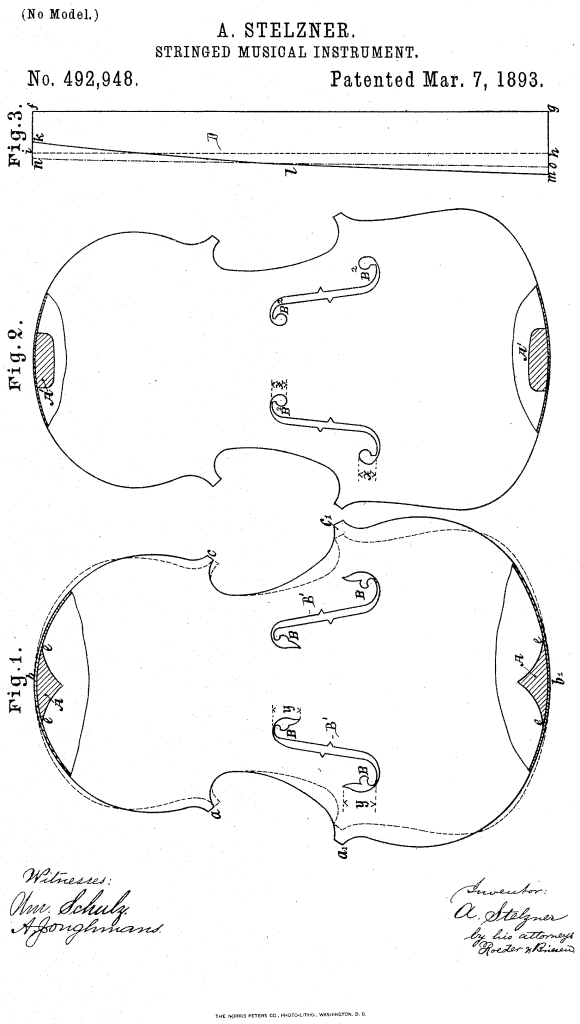Dr. Alfred Stelzner (US Patent 492,948)
| The following is a complete copy of Dr. Alfred Stelzner's 1893 U.S. Patent* (492,948); improvements in stringed musical instruments: UNITED STATES PATENT OFFICE ALFRED STELZNER, OF WIESBADEN , GERMANY . STRINGED MUSICAL INSTRUMENT. SPECIFICATION forming part of Letters Patent No. 492,948, dated March 7,1893 . To all whom it may concern: Be it known that I, ALFRED STELZNER, a subject of the German Emperor, residing at Wiesbaden, Germany, have invented certain new and useful Improvements in Stringed Musical Instruments, of which the following is a specification. This invention relates to an improved construction of stringed musical instruments, such as violins, violas, violottas and violoncellos, the v iolotta being a newly designed instrument, the pitch of which is an octave lower than that of the violin. The invention consists in the various features of improvement more fully pointed out in the claims. In the accompanying drawings: Figure 1 is a face view partly in section of the body of my improved musical instrument. Fig. 2 a similar view of the old style of instrument and Fig. 3 an edge view of Fig. 1. Heretofore, the outline of the instrument has been formed of arbitrary curves or segments of circles joined together as indicated by the dotted outline in Fig. 1. I propose to form the outline at the ends of the belly and back of the resonant chamber, that is to say the curves a, b, c, and a', b', a', are parts of true mathematical ellipses, as indicated by full lines Fig. 1, while at the same time, the upper and lower ellipses should have a definite proportion to each other. When this elliptic form is used, the sonorous waves are produced in a very favorable condition for effective resonance, as they strengthen instead of enfeeble one another, so that the vibrations of the molecules of air can develop the greatest energy. My invention further relates to the sound posts or blocks A, A, which connect the ends of the belly and back within the body of the instrument. These blocks have hitherto served only as supports and have been made of any convenient shape, as for instance the elongated shape shown at A', in Fig. 2, without regard to their effect upon the sound. I propose to make each of the sides e, of each post A, in the form of a parabolic curve, as shown in Fig. 1. This form, in combination with the elliptical outline of the instrument itself will have a beneficial effect upon the air waves, the curved faces e, forming parabolas whose foci, axes, and diameters, are in such a ratio with the elliptical outlines a, b, c, a', b', c', that the sonorous waves are everywhere intensified. The parabolic form also plays an important part in the formation of the sides of the instrument. In stringed instruments as hitherto constructed, when the sides were not of uniform height for their full length as indicated by the outlines f, g, h, i, Fig. 3, they were slightly higher at the lower than at the upper end of the instrument, this reduction in height being adopted for the sake of appearance. In my instrument the sides D, are made with outlines which form parabolic curves that maybe either simple or compound. The curve k, 1, n, shows a parabola of the first kind and the curve n, 1, o, shows a parabola of the second kind. The lower outlines of the sides, which are made considerably higher than in the instruments hitherto made, have also a parabolic curvature. The belly of the instrument is glued in the usual way upon the edges of the parabolic sides and is tightly pressed thereon by means of screw clamps. B', are the sound holes, the curved ends and the central slot of which form the outlines of the tongue-like parts B, B. In order to improve the vibration of these parts, they have been lengthened, as compared with the corresponding vibrating tongues B2 (Fig. 2) hitherto used, so that the length x, of the parts formed in the ordinary way, is much less than the length y, of the tongues B, constructed according to my improvement. In this way, an increased vibration of the tongues is obtained and the sound is intensified. In the above description, the exact position of the foci, and the extent and proportion of curvature of the elliptical and parabolic curves described, are not rigidly fixed, as the limits of variation of these proportions and curvatures are considerable, according to the size and character of the instrument. The essential feature of the invention is the selection instead of the arbitrary curves or outlines hitherto used, of elliptical and parabolic lines, they curves of which have such relative proportions, that the sonorous waves formed, shall produce resonance under the most favorable conditions. The form of the curves will thus always depend upon one another, so that the selection of one must determine the form of the other. What I claim is— 1. A stringed musical instrument having the belly and back of elliptic shape at the ends in combination with posts A, having parabolic sides, substantially as specified. 2. A stringed musical instrument having belly and back of elliptic shape at the ends and having the sides D, of parabolic shape, substantially as specified. 3. A stringed musical instrument having belly and back of elliptic shape at the ends and having elongated sound holes B', B, substantially as specified. In testimony whereof I hereunto sign my name, in the presence of two subscribing witnesses, this 13th day of August, 1891. ALFRED STELZNER.
*Courtesy of the US Patent and Trademark Office |
[Chamber Music] [Orchestral Music] [Operas] [Keyboard Music] [Top]
© All contents copyright by the International Draeseke Society/NA
